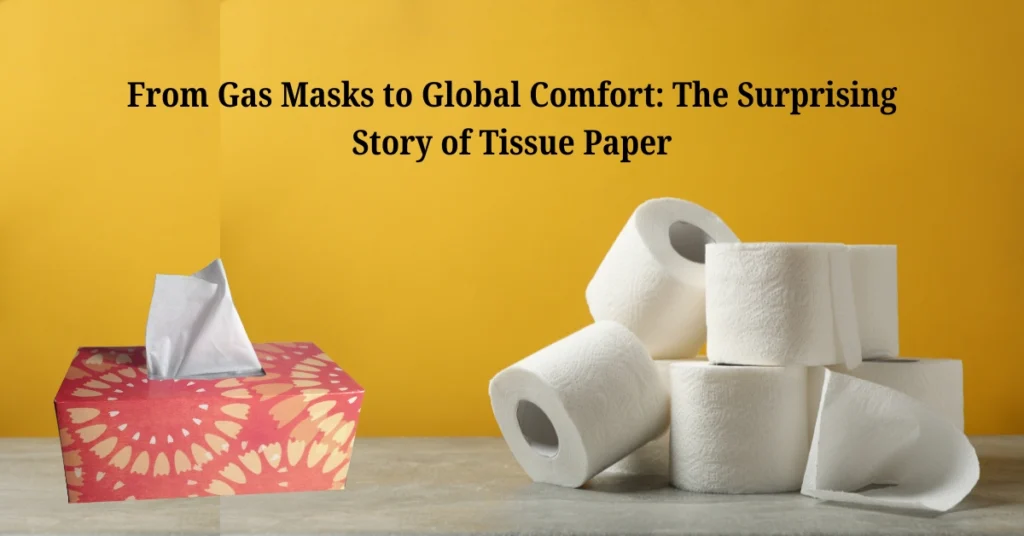The concept of using soft, absorbent material for personal hygiene isn’t new. Ancient civilizations used various materials, from leaves and corn cobs to rags and water. However, the modern tissue paper, as we know it, began to take shape in the late 19th and early 20th centuries.
While there isn’t one single inventor, the Scott Paper Company is widely credited with popularizing and commercializing toilet paper in rolls. In 1890, the company started producing the first toilet paper on a roll, although initially, it was sold as individual sheets because many people were embarrassed to ask for it.
The real breakthrough for tissue paper beyond just toilet paper came during World War I. Kimberly-Clark, an American paper company, developed a highly absorbent wadding made from creped cellulose, initially intended as a filter for gas masks. This material, called Cellucotton, was incredibly soft and absorbent, leading nurses to discover its effectiveness as a disposable bandage and, more significantly, as a disposable handkerchief.
From Battlefield to Bathroom: The Spread Begins
After the war, Kimberly-Clark realized the potential of Cellucotton for civilian use. In 1924, they launched Kleenex facial tissues, marketing them as a disposable alternative to cloth handkerchiefs, initially for removing cold cream and later for nasal hygiene. This marked a pivotal moment, as it introduced the idea of a disposable, soft paper product for everyday personal care.
Around the same time, other companies began to innovate. The Northern Tissue Company introduced “splinter-free” toilet paper in the 1930s, addressing a common complaint about earlier, rougher versions. Innovations in papermaking, such as the creping process that gives tissue its softness and bulk, continued to improve the product.
The invention and global spread of tissue paper are a fascinating story of innovation driven by necessity and evolving hygiene standards. Here’s how it unfolded:
The Dawn of Modern Tissue Paper:
The concept of using soft, absorbent material for personal hygiene isn’t new. Ancient civilizations used various materials, from leaves and corn cobs to rags and water. However, the modern tissue paper, as we know it, began to take shape in the late 19th and early 20th centuries.
While there isn’t one single inventor, the Scott Paper Company is widely credited with popularizing and commercializing toilet paper in rolls. In 1890, the company started producing the first toilet paper on a roll, although initially, it was sold as individual sheets because many people were embarrassed to ask for it.
The real breakthrough for tissue paper beyond just toilet paper came during World War I. Kimberly-Clark, an American paper company, developed a highly absorbent wadding made from creped cellulose, initially intended as a filter for gas masks. This material, called Cellucotton, was incredibly soft and absorbent, leading nurses to discover its effectiveness as a disposable bandage and, more significantly, as a disposable handkerchief.
From Battlefield to Bathroom: The Spread of Tissue Paper Begins
After the war, Kimberly-Clark realized the potential of Cellucotton for civilian use. In 1924, they launched Kleenex facial tissues, marketing them as a disposable alternative to cloth handkerchiefs, initially for removing cold cream and later for nasal hygiene. This marked a pivotal moment, as it introduced the idea of a disposable, soft paper product for everyday personal care.
Around the same time, other companies began to innovate. The Northern Tissue Company introduced “splinter-free” toilet paper in the 1930s, addressing a common complaint about earlier, rougher versions. Innovations in papermaking, such as the creping process that gives tissue its softness and bulk, continued to improve the product.
Also Read: Chime of Time” Rings in Monsoon with Bohoman Kobita Adda
Global Expansion and Diversification
The spread of tissue paper across the globe was a gradual process, influenced by several factors:
- Improved Hygiene Standards: As public health awareness grew, the demand for sanitary and disposable products increased. Tissue paper offered a convenient and hygienic alternative to reusable cloths.
- Technological Advancements: The development of more efficient papermaking machinery and processes made mass production of tissue paper economically viable, leading to lower prices and wider accessibility.
- Marketing and Advertising: Companies played a crucial role in educating the public about the benefits of tissue paper, shifting cultural norms around personal hygiene. Early advertisements often highlighted the convenience and health aspects of disposable tissues.
- Wartime Influence: As seen with Cellucotton, wartime innovations often have lasting civilian applications. The utility of disposable paper products for hygiene and medical purposes during conflicts further cemented their importance.
- Urbanization and Modern Lifestyles: The growth of cities and more fast-paced lifestyles contributed to the demand for convenient, disposable products.
The invention and global spread of tissue paper are a fascinating story of innovation driven by necessity and evolving hygiene standards. Here’s how it unfolded:
By the mid-20th century, tissue paper products — including toilet paper, facial tissues, paper towels, and napkins — became household staples in developed countries. Their adoption in developing nations followed as economies grew and living standards improved.
Today, tissue paper is a multi-billion dollar industry, with continuous innovation in terms of sustainability, softness, strength, and specialized uses. The humble invention born out of necessity has truly become an indispensable part of global hygiene and daily life.



